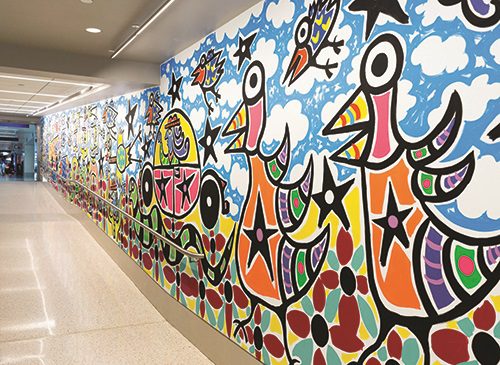Why did the chicken cross the road? To admire its pals on a mural at Gerald R. Ford International Airport (GRR) in Grand Rapids, MI.
Why did the chicken cross the road? To admire its pals on a mural at Gerald R. Ford International Airport (GRR) in Grand Rapids, MI.
Chickens Don’t’ Fly Too Much, by Reb Roberts, features repeating patterns of bold, stylized chickens and other animals that are on the move—just like the travelers who pass the 80-foot mural on their way in and out of Concourse A.
Art-savvy passengers instantly recognize the piece as a “Reb” due its signature style and, quite literally, the way the painter signs his pieces. Roberts, a self-taught artist, began painting similar murals on boarded up storefronts, in vacant lots and at construction zones throughout Grand Rapids in the 1990s. When his vibrant pieces started gaining commercial success, he and his wife founded The Sanctuary Folk Art Gallery, which sold his creations and also helped local artists experiencing economic hardship or homelessness by displaying their work.
Roberts’ mural at GRR was funded by a grant from the Frey Foundation to showcase the talents of West Michigan artists. “For the past decade, it’s been a dream of mine to have work displayed at Ford Airport,” he comments.
The artist realized that dream by painting six hours a day for eight consecutive days. As he worked, passengers and employees often thanked him for sharing his talents.
Airport President/Chief Executive Officer Tory Richardson and other officials debuted Roberts’ cheery, colorful creation last September. The following month, GRR unveiled a bronze statue of its namesake, former U.S. President Gerald R. Ford.



